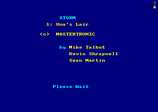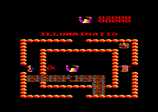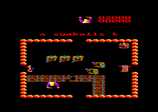Storm
Copyright : Mastertronic | Reviewed by : Ritchardo
The evil wizard Una Cum has captured Corrine, wife to Prince Storm, and imprisoned her in his underground lair while he searches for a box called The Fear
Storm has enlisted the help of his old friend, the wizard Agravain Undead, who knows the whereabouts of Una Cumâ??s lair and some of its many secrets.
Agravain takes Storm to the Western edge of the land and shows him the ruined abbeyâ??s window, which looks over another dimension of strange proportions.
â??Unaâ??s abode lies beneath the abbeyâ?? explained Agravain. â??You can see it through the floorboards over here.â??
Graphics
Viewed from above, Storm can be a little confusing to look at, at first until you get to grips with the perspective and once this barrier is hurdled, the game begins to open itself up both in terms of gameplay and appreciation of the graphics.
A wide range of colour has been used to bring the dungeons and its many minions to life to good effect. Although basic in design (everything is blocky!) the viewpoint gives the game a startling edge over many of its contemporaries.
The perspective is not without fault however as the overlaying of scenery can make things a little confusing at times and its difficult to work what scenery you can pass through and what you cannot.
Sound
Very dodgy sound effects play throughout the game. Itâ??s not that the quality of the sounds themselves is that bad itâ??s just the delivery of them that drags proceedings down. Effects are tinny and sometimes sound quite distant and the next instant is echoing around the room meaning volume control is a must.
Gameplay
The original Gauntlet clone on the Amstrad, Storm is a complex and challenging adventure that will tax the brain as well as the trigger finger. The odds are almost overwhelming at times but there is a real sense of exploration and interest as you battle your way further and deeper into Una Cumâ??s lair.
Controlling your character (surprisingly you play Agravain in one-player mode) is difficult to get used to at first as the programmers have adopted the old isometric exploration game method of control: one key to turn clockwise, another to turn anti-clockwise and a third to move forward. After a while though this becomes second nature and does not detract from the game at all.
One thing that really struck me when playing the game was the speed at which your character can move and turn, allowing lighting quick reactions and arcade style blasting to escape grave situations.
The two-player game adds an extra dimension by requiring players to co-operate in order to survive and was probably one of the most complex two player games available at the time.



 Latest additions to the review archives
Latest additions to the review archives Thanks to everyone below for your contributions
Thanks to everyone below for your contributions Bookmark
Bookmark








